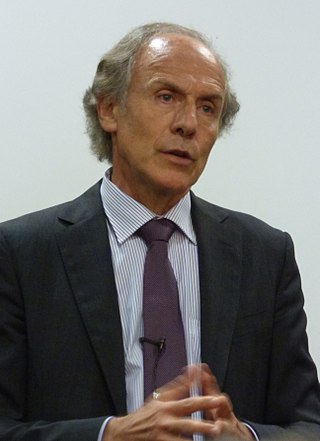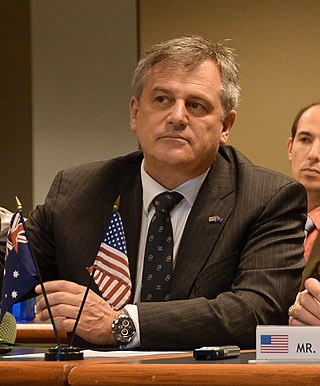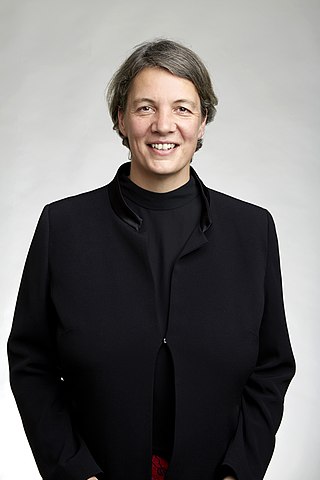Related Research Articles
Keith Edward Bullen FAA FRS was a New Zealand-born mathematician and geophysicist. He is noted for his seismological interpretation of the deep structure of the Earth's mantle and core. He was Professor of Applied Mathematics at the University of Sydney in Australia from 1945 until 1971.
Louis-Noël Moresi is a Professor of Computational Mathematics & Geophysics at The Australian National University. He has deeply influenced the understanding of the Geophysics community through his own research as well as providing software for the community to use.

The Eureka Prizes are awarded annually by the Australian Museum, Sydney, to recognise individuals and organisations who have contributed to science and the understanding of science in Australia. They were founded in 1990 following a suggestion by science journalist Robyn Williams.

Alan Simon Finkel is an Australian neuroscientist, inventor, researcher, entrepreneur, educator, policy advisor, and philanthropist. He was Australia’s Chief Scientist from 2016 to 2020. Prior to his appointment, his career included Chancellor of Monash University, President of the Australian Academy of Technology and Engineering (ATSE), and CEO and founder of Axon Instruments, and CTO for the electric car start-up Better Place Australia.
Marshall (Hal) Davidson Hatch AM (born 24 December 1932) was an Australian biochemist and plant physiologist. He was the chief research scientist at the CSIRO Division of Plant Industry in Canberra. He is a Fellow of the Australian Academy of Science, a Fellow of the Royal Society, a Foreign Associate of the US National Academy of Sciences and was awarded Honorary Doctorates from the University of Götting youen and the University of Queensland. In Australia, in 1966, he elucidated, jointly with Charles Roger Slack, the C4 pathway for the fixation of carbon, which is also sometimes known as the Hatch-Slack pathway. He is now retired.
Richard J. Hobbs FAA, is an Emeritus Professor, ARC former Australian Laureate Fellow and ecologist at the University of Western Australia, Perth, Australia. He is a fellow of the Australian Academy of Science and a Highly-Cited author who has written extensively in the areas of vegetation dynamics and management, ecosystem fragmentation, ecosystem rehabilitation and restoration, landscape ecology, and conservation biology. His research focused on managing ecosystems in a rapidly changing world and the implications of environmental and biological change for conservation and restoration.
Ralph Owen Slatyer was an Australian ecologist, and the first Chief Scientist of Australia from 1989 to 1992.

Sir Edward Byrne is a neuroscientist who, as of September 2024, serves as President of King Abdullah University of Science and Technology (KAUST), located in Thuwal, Saudi Arabia. Byrne served as President and Principal of King's College London from August 2014 until January 2021. and was previously President Vice-Chancellor of Monash University.
Michael Cowley is an Australian physiologist. He is best known for his mapping of the neural circuits involved in metabolism and obesity and diabetes treatment. He is a professor in the Department of Physiology at Monash University in the Faculty of Biomedical and Psychological Sciences. He is also a director of the Australian diabetes drug development company, Verva Inc, and director of the Monash Obesity & Diabetes Institute] (modi).

Jasper A. Vrugt is a Dutch scientist/engineer/applied mathematician known for his work in the earth sciences: surface hydrology, soil physics, hydrogeophysics, hydrometeorology, and geophysics. Vrugt is an assistant professor at the University of California, Irvine and holds a joint appointment in the Department of Civil and Environmental Engineering and the Department of Earth System Science. He also holds a part-time appointment as associate professor at the University of Amsterdam, Faculty of Science (CGE).

Douglas James Hilton is an Australian molecular biologist. He is the CEO of CSIRO and immediate past Director of the Walter and Eliza Hall Institute of Medical Research in Melbourne, Australia. His research has focused on cytokines, signal transduction pathways and the regulation of blood cell formation (hematopoiesis). Hilton was the President of the Association of the Australian Medical Research Institutes (AAMRI) from 2014-16.
Peter Hannaford is an Australian academic and university professor. He is the Director of the Centre for Atom Optics and Ultrafast Spectroscopy at Swinburne University of Technology in Melbourne, and winner of the Walter Boas Medal in 1985.

Alexander Zelinsky is an Australian computer scientist, systems engineer and roboticist. His career spans innovation, science and technology, research and development, commercial start-ups and education. Professor Zelinsky is Vice-chancellor and President of the University of Newcastle joining the university in November 2018. He was the Chief Defence Scientist of Australia from March 2012 until November 2018. As Chief Defence Scientist he led defence science and technology for Australia's Department of Defence.

Michelle Yvonne Simmons is an Australian quantum physicist, recognised for her foundational contributions to the field of atomic electronics.
James Vladimir Taranik was an American scientist and educator who worked in the area of earth-observation satellite remote sensing. He was Chief of NASA's Non-Renewable Resources Branch and Program Scientist of the Space Shuttle's first scientific flights with cargo that included experiments related to geology, atmospheric chemistry, meteorology, marine biology, and plant physiology in the earth and life sciences. He also held various positions in the Nevada System of Higher Education, including the Desert Research Institute and the Mackay School of Earth Sciences and Engineering.
Kostya (Ken) Ostrikov is a Ukrainian-Australian physicist and academic, professor at Queensland University of Technology and scientist at the Commonwealth Scientific and Industrial Research Organisation, member of Academia Europaea. He was awarded the Pawsey Medal (2008) and the Walter Boas Medal (2010).
Murali Sastry is an Indian material chemist, nanomaterial scientist and the chief executive officer of the IITB-Monash Research Academy. He is a former chief scientist at Tata Chemicals and a former senior scientist at the National Chemical Laboratory. He is known for his studies on surfaces, films and materials chemistry and is an elected fellow of Maharashtra Academy of Sciences and the Indian Academy of Sciences. The Council of Scientific and Industrial Research, the apex agency of the Government of India for scientific research, awarded him the Shanti Swarup Bhatnagar Prize for Science and Technology, one of the highest Indian science awards, in 2002, for his contributions to chemical sciences.

Trevor John McDougall is an Australian physical oceanographer specialising in ocean mixing and the thermodynamics of seawater. He is Emeritus Scientia Professor of Ocean Physics in the School of Mathematics and Statistics at the University of New South Wales, Sydney, Australia, and is Past President of the International Association for the Physical Sciences of the Oceans (IAPSO) of the International Union of Geodesy and Geophysics.
Thang Hoa San is an Australian chemist of Chinese-Vietnamese background.
Aibing Yu is a Chinese–Australian chemical engineer, serving as Pro Vice-Chancellor and Foundation President (Suzhou) at Monash University where he is also Sir John Monash Distinguished Professor Director of ARC Research Hub for Smart Process Design and BHP-Baowu-Monash Knowledge Centre for LCM.
References
- 1 2 3 4 5 6 7 8 9 10 11 12 13 "Who's Who Live (Australia)". Crown Content ABN 37 096 393 636. Archived from the original on 9 August 2011. Retrieved 29 June 2011.
- 1 2 3 4 5 6 7 8 9 10 11 12 13 14 15 16 Alafaci, Annette (7 February 2011) [15 November 2005]. "Biographical entry. Hobbs, Bruce Edward (1936 – )". Encyclopedia of Australian Science. Retrieved 31 July 2011.
- 1 2 Mendez, Torrance (3 May 2006). "WA's chief scientist quits over policy stoush with Carpenter". The West Australian. Perth, Western Australia: West Australian Newspapers Limited. p. 1.
- ↑ "In Conversation – 27 April 2006 – Bruce Hobbs. (transcript)". Radio National. Australian Broadcasting Commission. Retrieved 31 July 2011.
- 1 2 "Alumni Sidneienses. (database online)". Alumni of the University of Sydney. The University of Sydney. 2011. Archived from the original on 8 April 2011. Retrieved 31 July 2011.
- ↑ "Entry. Hobbs, Bruce E. Tectonic studies in the Central West of N.S.W." Catalogue. University of Sydney. Library.(database online). The University of Sydney. 2011. Retrieved 31 July 2011.
- ↑ Australian Government. "Australian Honours database. HOBBS, Bruce Edward. Centenary Medal". It's an honour.
For service to Australian society and science.
- ↑ Australian Government. "Australian Honours database. HOBBS, Bruce Edward. Officer of the Order of Australia". It's an honour. Archived from the original on 3 March 2016. Retrieved 30 July 2011.
For service to science, particularly in the field of structural geology as a leader in the development of innovative research centres and mineral exploration technologies.